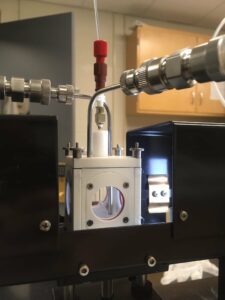Materials and Interfaces
Chemical engineers leverage knowledge of material properties and interfacial mass transfer to achieve desired outcomes. The chemistry and physics required to design and describe the behavior of these systems are of paramount importance and find engineering significance across many disciplines.
Surface Properties of Atmospheric Aerosol Mimic Solutions

In the atmosphere, organic chemicals that are deposited on the surface of microscopic aerosols and cloud droplets can affect how long droplets persist before they react away or rain out. Because some chemicals are more likely to stay at droplet surfaces rather than mix in, even trace amounts can lead to disproportionately significant effects – which can lead to misrepresentation of their properties and effects in existing climate models!
At Lafayette ChBE, we measure the surface properties of systems that emulate the high surface-volume ratio of aerosols. By better understanding their behavior and chemistry, we can better estimate how aerosols change the overall energy balance in the atmosphere.